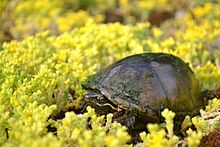Common musk turtle
| Sternotherus odoratus | |
|---|---|
 |
|
| Scientific classification | |
| Kingdom: | Animalia |
| Phylum: | Chordata |
| Subphylum: | Vertebrata |
| Class: | Reptilia |
| Order: | Testudines |
| Family: | Kinosternidae |
| Subfamily: | Kinosterninae |
| Genus: | Sternotherus |
| Species: | S. odoratus |
| Binomial name | |
|
Sternotherus odoratus (Latreille in Sonnini & Latreille, 1801) |
|
| Synonyms | |
|
|
Sternotherus odoratus is a species of small turtle native to southeastern Canada and much of the Eastern United States. It is also known as the common musk turtle or stinkpot due to its ability to release a foul musky odor from scent glands on the edge of its shell, possibly to deter predation.
Stinkpots are small black, grey or brown turtles with highly domed shells. They grow to approximately 5.1–14 cm (2.0–5.5 in) and average in weight at 603 g (1.329 lb). They have long necks and rather short legs. The yellow lines on the neck are a good field marker, and often can be seen from above in swimming turtles. Males can usually be distinguished from females by their significantly longer tails and by the spike that protrudes at the end of the tail. The anal vent on the underside of the tail extends out beyond the plastron on males. Females are also typically larger than males. The head is vaguely triangular in shape, with a pointed snout and sharp beak, and yellow-green striping from the tip of the nose to the neck. Barbels are present on the chin and the throat. Their plastrons are relatively small, offering little protection for the legs, and have only one transverse, anterior hinge.Algae often grow on their carapaces. Their tiny tongues are covered in bud-like papillae that allow them to respire underwater.
Musk turtles are almost entirely aquatic, spending the vast majority of their time in shallow, heavily vegetated waters of slow moving creeks, or in ponds. They typically only venture onto land when the female lays her eggs, or in some cases, to bask. They can climb sloping, partially submerged tree trunks or branches to as much as 2 m (6.6 ft) above the water surface, and have been known to drop into boats or canoes passing underneath. Their defense mechanism is to excrete a musk scent from a small gland in their underside, hence the name musk turtle. This is used to scare away predators and natural enemies.
...
Wikipedia

